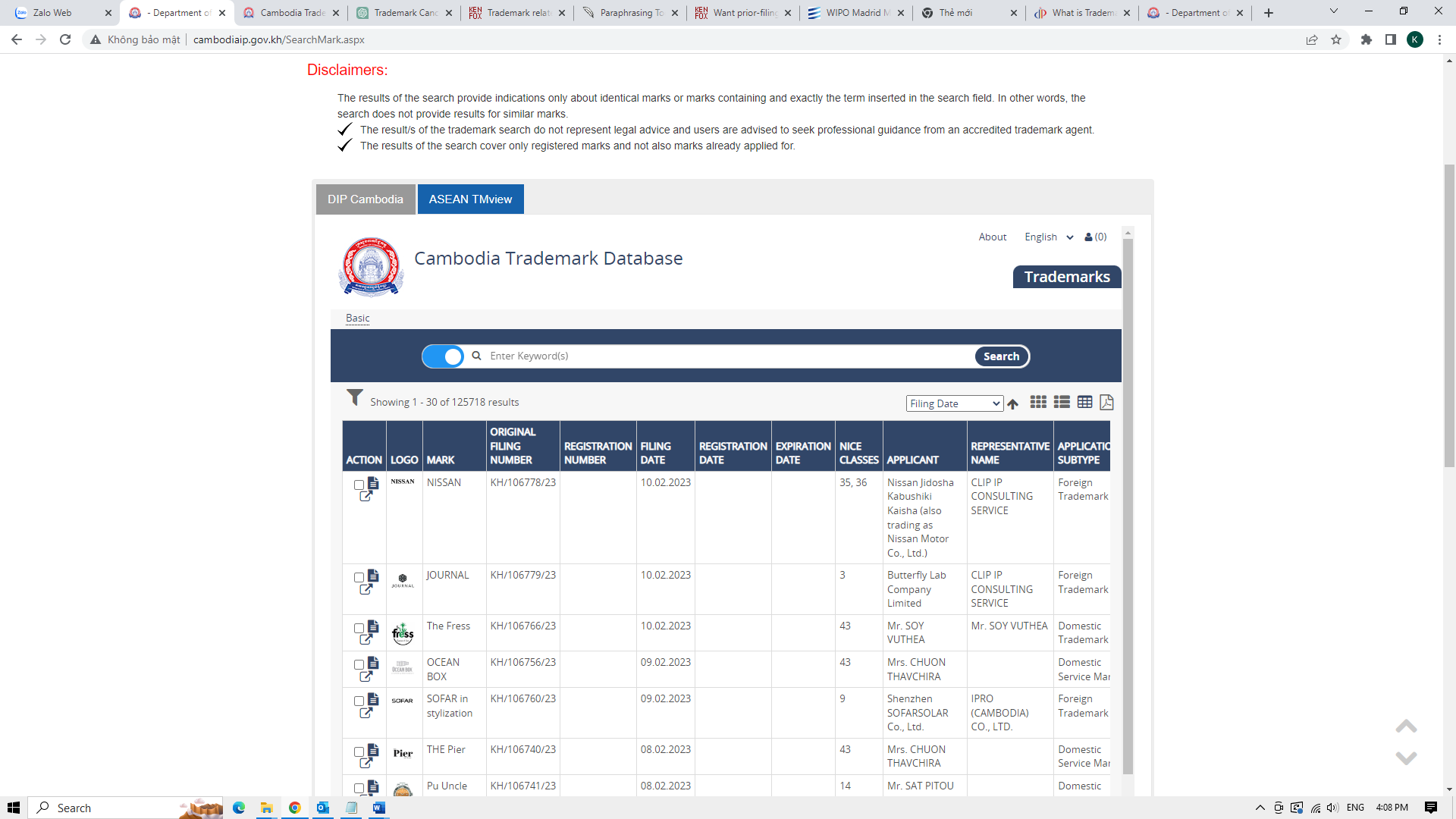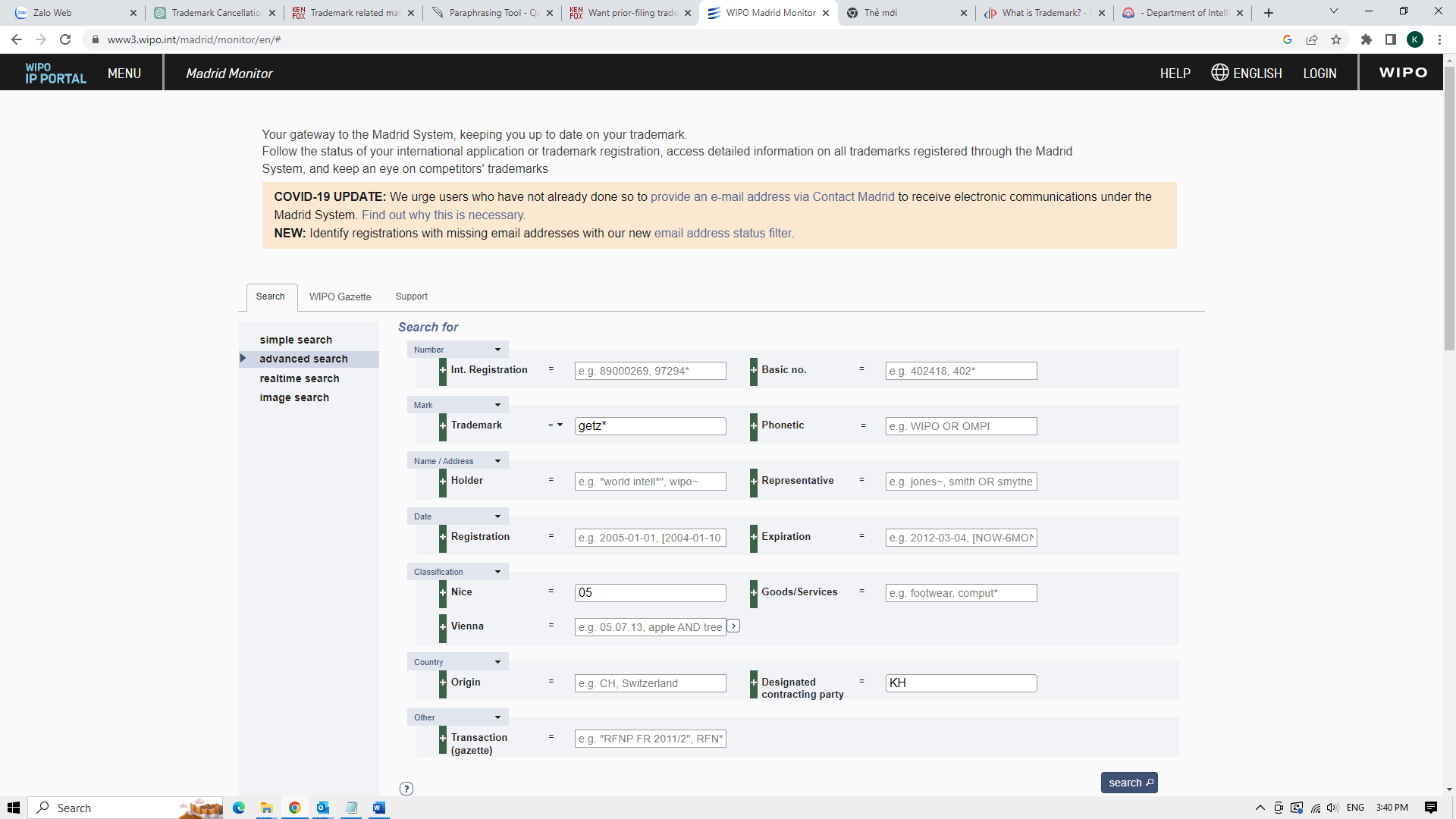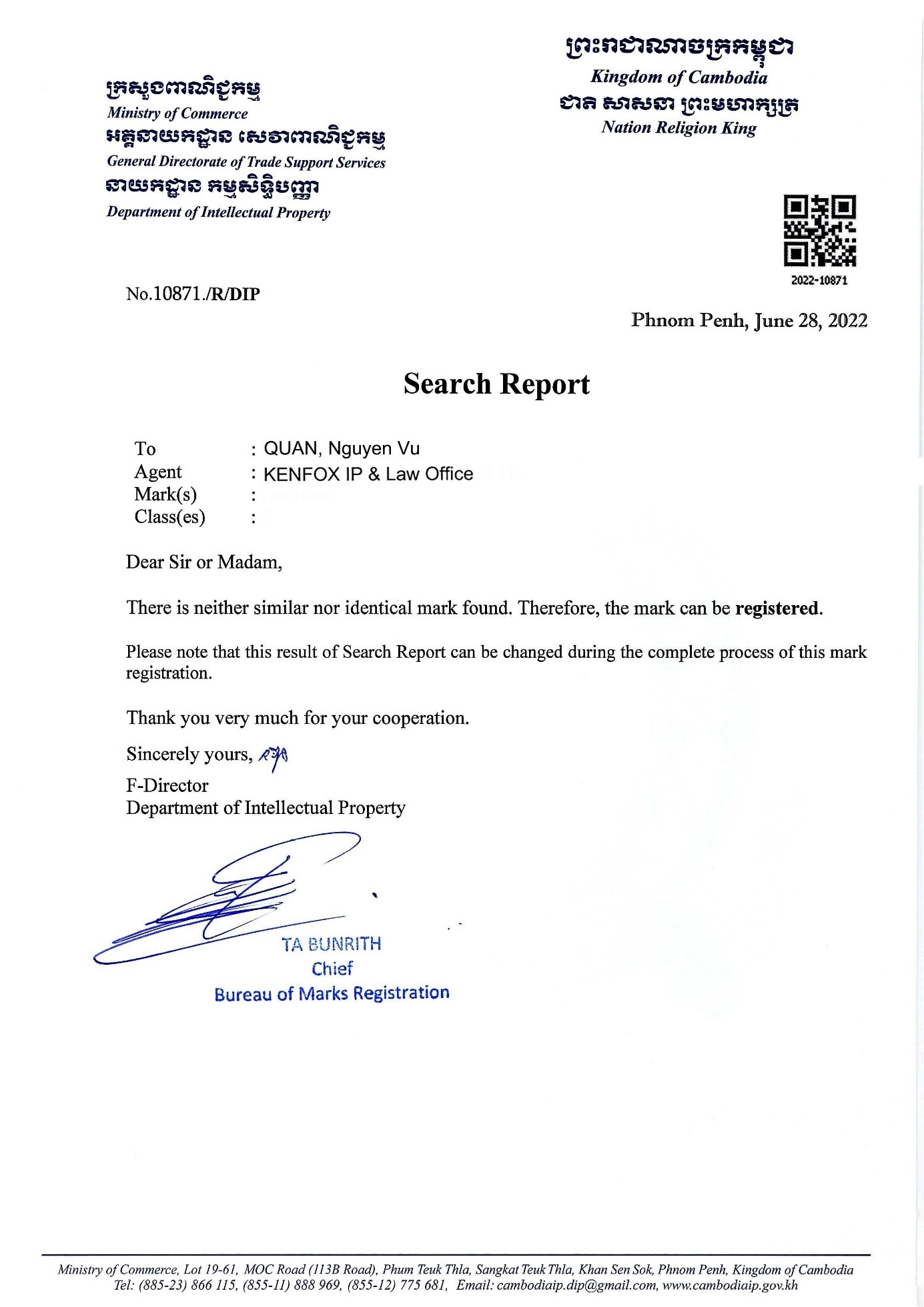Conducting a trademark search in Cambodia: Why and How?
1. Why should a trademark search in Cambodia be conducted?
Before filing a trademark application in Cambodia, it is advisable to conduct a search based on the trademark database of the Department of Intellectual Property of Cambodia (DIP) to determine the registrability of a proposed mark. Conducting a trademark search prior to filing is highly advised for a number of reasons.
- Avoid potential trademark infringement: Prior to submitting an application for trademark registration in Cambodia, conducting a trademark search may help identify any existing marks that are similar to the one you plan to register. This can assist you avoid infringing on others’ trademark rights and avoid expensive legal conflicts in the future.
- Save time and resources: If a pre-filing trademark search finds that your intended mark is already in use, you can save time and money by not preparing and filing an application that is likely to be refused.
- Improve chances of success: A pre-filing trademark search can help you determine the chances of successfully registering your trademark. This can help you identify any potential obstacles or objections that may arise during the application process, allowing you to address them before filing your application.
- Increase market awareness: A pre-filing trademark search can provide significant insight into the products and services offered under comparable trademarks. This data can assist you in making informed decisions regarding your business strategy and avoiding future problems.
- Know about the strenght of the proposed mark: A trademark’s strength relates to its capacity to identify and differentiate one party’s goods or services from those of another. The greater the strength of a trademark, the greater the likelihood that it will be registered and provide the owner with a higher level of protection. If the search indicates that a large number of comparable trademarks are already in use, this may indicate that your proposed mark is weak and difficult to differentiate from others. Conversely, if your proposed mark looks to be distinct and not too similar to existing trademarks, it may be deemed powerful.
2. How to conduct a trademark search in Cambodia?
You can do a trademark search using the online database of trademarks, or you can request that the Department of Intellectual Property of Cambodia undertake an official trademark search.
2.1. How to conduct an online trademark search in Cambodia?
The trademark database of Cambodia is available in DIP’s website and the WIPO’s platform (WIPO Monitor) at:
As such, you may choose one of the above websites to conduct an online trademark search.
2.1.1. Conducting an online trademark search in DIP’s website at <http://www.cambodiaip.gov.kh/SearchMark.aspx>
Below is the interface of DIP’s website for conducting an online search:

2.1.2. Conducting an online trademark search in WIPO’s platform (WIPO Monitor) at <https://www3.wipo.int/madrid/monitor/en/> or <https://legacy.branddb.wipo.int/branddb/en/index.jsp>
Here is a step-by-step guide on how to conduct a trademark search in Cambodia using DIP’s website and the WIPO (World Intellectual Property Organization) Monitor platform:
- Go to the DIP’s website or the WIPO Monitor website: Open your web browser and navigate to the above websites.
In the DIP website, just enter the name of your mark in the search field to conduct the search. This search tool is not so friendly to users. As such, it is more advisalble to search trademarks in the rest websites.
- Select the search criteria: Type your trademark to the search field “trademark”, the class of goods/services in the search field “Nice”.
- Select the jurisdiction: At the search field “Designated contracting party”, please choose “KH” which is the abbreviation of “Cambodia”.
- Perform the search: Click the “Search” button to initiate the search. The results will show you trademarks that are similar to your proposed trademark.
- Review the search results: Review the search results to identify any existing trademarks that are similar to your proposed trademark. Pay attention to trademarks that have the same or similar name, logo, or design, or that cover the same or similar goods or services.
- Analyze the results: Analyze the search results to determine the likelihood of your proposed trademark being accepted for registration. Consider the similarity of your proposed trademark to existing trademarks and the strength of these existing trademarks.
Please see a screenshot when you would like to conduct a trademark search for “GETZ” in Class 05 in Cambodia as an example below:

Critical notes:
- Search accuracy: Although WIPO’s database of trademarks is a significant resource, it is crucial to remember that the information it contains may not always be current or exhaustive. Therefore, the absence of identical marks in the search results does not guarantee that your proposed mark is registrable. It is recommended to do an official search for trademarks. See our recommendation below.
- Trademark classifications: According to the goods or services they provide to identify, trademarks are classified into various classes. Consider the classifications of your proposed trademark as well as any comparable trademarks you discover during your search.
- Likelihood of confusion: A trademark search is conducted to identify whether your proposed mark is comparable to any existing marks. Consider the potential of confusion between two comparable trademarks if you identify a similar trademark. The greater the possibility of confusion, the lower the likelihood that your proposed trademark will be registered.
2.2 How to conduct an official trademark search in Cambodia?
You can request that the Department of Intellectual Property of Cambodia (DIP) undertake an official search for a trademark. DIP is accountable for managing the Cambodian trademark registry.
Involved costs: It may cost over USD 100.
Timeline: An official trademark seach may be available within 15-20 working days and
When DIP receives a trademark search request, an examiner will undertake an official trademark search to determine the availability of the proposed mark. The processes that an examiner may use to perform a trademark search are outlined below:
- Review of trademark database: DIP will assign a responsible examiner to undertake a check of its trademark database to assess if the proposed trademark is identical or confusingly similar to any registered or pending registration trademarks. The trademark database contains information on trademarks that have been filed, registered, or abandoned, and the examiner will analyze this database to see if the proposed mark is in conflict with existing marks.
- Comparison of the proposed mark with existing marks: The examiner of DIP will compare the proposed trademark to the database’s existing trademarks. If the examiner concludes that the proposed trademark is confusingly similar to an existing mark, DIP may cite the existing mark to conclude that the proposed mark cannot be registered.
- Consideration of other relevant factors: The examiner may also assess any other relevant considerations that may affect the registrability of the proposed trademark, such as whether it is a generic term, if it is descriptive or suggestive, or whether it is a well-known trademark in another jurisdiction, etc.

Critical notes:
The official report of DIP’s trademark search is regarded as a trustworthy source of information regarding the availability of proposed trademarks subject to the search in Cambodia. The search report is based on a thorough assessment of the trademark register and other pertinent sources of information, and it is compiled by qualified examiners who are familiar with trademark law and practice in Cambodia.
It is essential to note, however, that the DIP trademark search report is merely a preliminary evaluation of the availability of a mark and does not guarantee that the proposed mark will be accepted for registration. The following considerations must be made:
- A preliminary assessment: Notably, the DIP trademark search report is only a preliminary review of a mark’s availability and does not guarantee that the proposed mark will be accepted for registration.
- Limited scope: The trademark search report might not include all pertinent trademarks, and it might not reflect the most recent information.
- Focus on registrability: The trademark search report focuses on assessing the registrability of marks, not their enforceability. Even if a trademark is granted for registration, it may still infringe on the rights of others, or it may be susceptible to challenge in the future, e.g.e.g. a well-known trademark for the goods/services other than those bearing your proposed trademark.
To sum up, the official trademark search report issued by DIP can be a useful tool for assessing the availability of a proposed trademark, but it should not be the sole source of information.
By Nguyen Vu QUAN
Partner & IP Attorney
- Trademark Related Matters in Cambodia
- How did “DING TEA” milk tea win the brand battle in Cambodia?
- The contribution of Trademark Registration in Cambodia to Business Development
- How to respond to pharmaceutical trademark refusals in Cambodia?
- How to effectively handle a trademark infringement in Cambodia?

